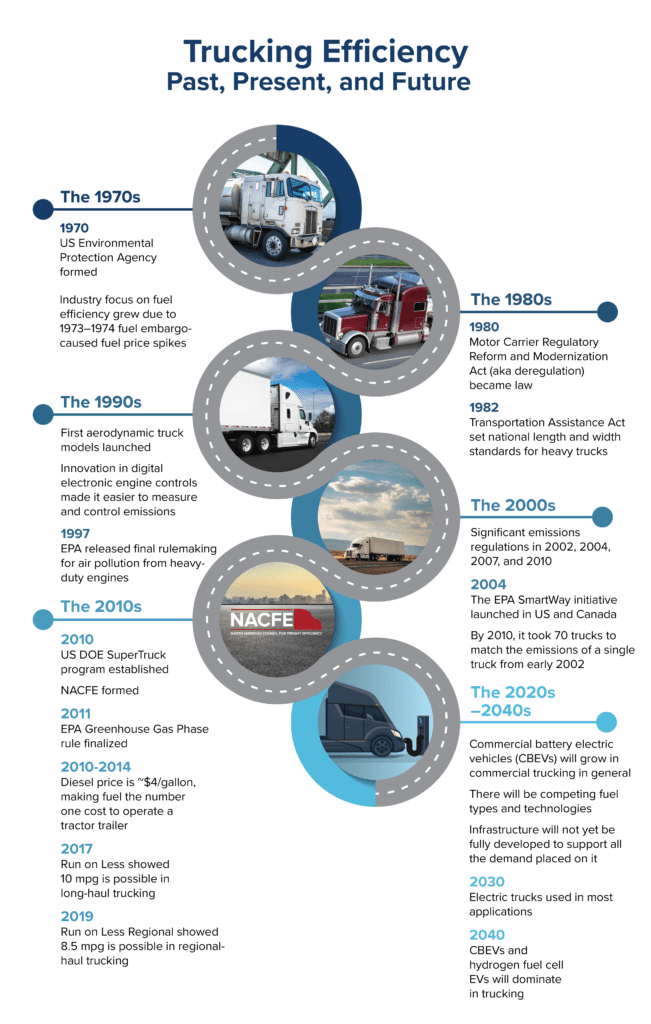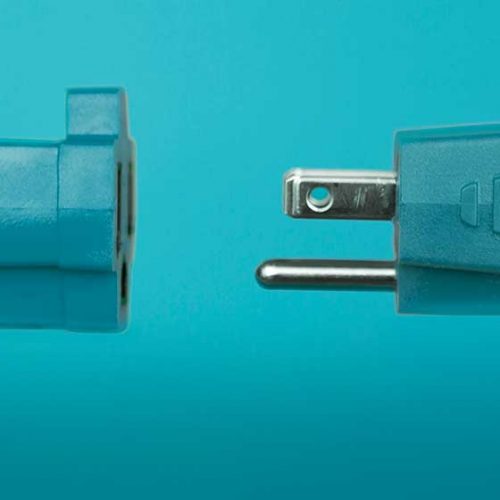
Keep on Truckin’—50 Years of Efficiency Advancements
On the 50th Anniversary of Earth Day
On the 50th anniversary of Earth Day—and as the COVID-19 pandemic makes the world acutely aware of trucking’s critical role in getting us everything we need and want—we want to share some of the amazing progress the trucking industry has made to be more efficient in hauling the world’s goods.
Let’s take a decade-by-decade stroll from the 1970s to today—and beyond—to see how combined industry actions, government regulations, and technology created huge gains in cost savings and environmental efficiencies while at the same time allowing truckers to haul more goods over longer distances each decade. We’ll also look at how the efficiency improvements over the past 50 years could be dwarfed in scale and speed by future gains, particularly through new technologies like electrification and hydrogen fuel cells.
The 1970s
A few months after the first Earth Day in May 1970, the US Environmental Protection Agency began working to consolidate a variety of federal research, monitoring, standard-setting, and enforcement activities to ensure environmental protection. Trucking was one area of focus.
By the end of the 1970s, the federal government had built out the main corridors of the Interstate Highway System. By increasing the number of highways, trucks could move goods at much higher speeds and with less stop-and-go traffic, providing an efficiency boost to the industry.
At the time, fixed shipping rates and low fuel prices meant there was little motivation for fleets to be efficient on their own. However, the oil embargo from 1973 to 1974 opened people’s eyes to the fact that fuel might not always be cheap nor abundant, and helped drive an industry-led focus on improving efficiency. Fuel efficiency got another regulation boost when, to save fuel through lower speeds, the national speed limit was set to 55 mph in January 1974.
The 1980s
Although fuel economy remained around five miles per gallon (mpg) through the 1980s, new federal regulations began to boost trucking efficiency significantly. The Motor Carrier Regulatory Reform and Modernization Act became law in January 1980, removing “fixed” shipping rates and implementing regulations to end wasteful trucking practices, such as limiting what commodities could be hauled where by each carrier.
The Transportation Assistance Act of 1982 set national length and width standards for heavy trucks. Previously, regulations on truck size varied by state, meaning truck drivers would sometimes stop at a border and switch trailers to remain legal. Less stops improved fuel efficiency.
Prior to the 1980s, most trucks used a “cabover” design, in which the driver’s cab was directly over the engine. Cabovers essentially ceased over this decade as “long and tall” conventional trucks—with the engine mounted in front of the driver—became the industry’s truck of choice due to the trailer being the only regulated length and increased driver comfort, among other factors. Having a single model configuration for both the tractor and the trailer helped the industry focus on improving efficient design more quickly.
These regulations and truck design aspects, combined with competition among carriers, resulted in industry consolidation and the emergence of many strong, efficient fleets.
The 1990s
Fuel prices remained relatively stable over this decade, averaging $1.25 per gallon. The decade saw truck manufacturers and major component suppliers consolidate into fewer, stronger players, bringing higher quality, more efficient trucks and trailers to the North American market. Manufacturers launched aerodynamic models with rounder features than the original boxier conventional trucks, further reducing fuel usage. In addition, innovation in digital electronic engine controls, which replaced analog controls, opened up emissions and efficiency options previously unavailable.
In 1997, the EPA mandated a major environmental change for the trucking industry, requiring large reductions in nitrogen oxides (NOx) and particulate matter from heavy-duty engines to reduce air pollution.
These changes came in the face of increasing global logistics, as more goods moved across longer distances than in previous decades, particularly from India and China.
The 2000s
This decade saw significant emissions regulations enacted in 2002, 2004, 2007, and 2010, designed to lower NOx and particulate matter in commercial vehicles. The results were impressive: by 2010, it took 70 trucks to match the emissions of a single truck from early 2002.
The EPA, which previously had primarily focused on cleaning vehicle exhaust, moved to efforts to lower fuel consumption by establishing greenhouse gas regulations for commercial trucks and buses. The fuel saving technologies that emerged were forecast to save the industry $170 billion in fuel costs while removing 1.1 billion tons of CO2 emissions. This was a very collaborative period when the government, trucking industry, and nongovernmental organizations (NGOs) worked together to write these standards and ensure goals were achieved.
The early 2000s was also characterized by wild fluctuations in fuel prices with diesel ranging from a low of $2 a gallon to a high of $5 a gallon in the span of a few months. Because of the higher fuel prices, operators demanded fuel-saving options for their vehicles.
The EPA SmartWay initiative, a voluntary efficiency program, launched in 2004 in the United States and Canada with extensive fleet participation, resulted in more adoption and cooperation between government and industry.
Stimulus funds from the 2008 recession created the Department of Energy’s Supertruck program, which helped fund the development and launch of more aggressive aerodynamics and powertrain solutions.
The 2010s
Diesel fuel prices remained high in this decade, as much as $4/gallon, making fuel the highest cost for trucking. The EPA mandated better fuel efficiency for new trucks in the Greenhouse Gas Phase I rule in August 2011. This was followed by the Greenhouse Gas Phase II rule, to be implemented in 2021, 2024, and 2027.
In 2010, Rocky Mountain Institute formed the North American Council for Freight Efficiency (NACFE) to drive development and adoption of efficiency-enhancing, environmentally beneficial, and cost-effective technologies, services, and methodologies in partnership with the North American freight industry. In 2017 and 2019, NACFE’s Run on Less fuel efficiency demonstrations showed that 10 mpg was possible in long-haul trucking and 8 mpg was possible in regional haul trucking, all using production trucks fitted with commercially available technology.
Other factors—including the fear of high fuel prices, the reality of the implementation of GHG regulations, and public pressure on the industry to be more sustainable—also motivated the industry to focus on improving fuel efficiency.
2020–2040
The next two decades are poised to build on the past 50 years, beginning a transformation in trucking with zero-emissions-vehicle solutions, connectivity, and automation all offering major opportunities. Now the COVID-19 crisis, and resulting new economic and logistical challenges, are testing the trucking industry. However, we still have an opportunity to emerge with a cleaner, more resilient freight system that strengthens our supply chain while reducing greenhouse gas emissions in ways that lower bottom-line fleet costs.
In the near term, a relatively low hanging fruit—possibly a disruptive and relatively easy win that this industry already supports—is electric trucks, or commercial battery electric vehicles (CBEVs). This is particularly true for regional haul trucking, which makes up a large and growing portion of overall trucking in North America today, and that often has routes shorter than 500 miles that allow trucks to return to a central location at night for charging.
CBEVs not only produce “cleaner skies” by reducing—or sometimes eliminating—greenhouse gas emissions, but are also nearly silent, improving quality of life for people who live near highways or in crowded cities with fleets of trucks delivering goods to stores.
Long-haul trucking will also benefit from emerging electric truck technologies, particularly batteries that do not require charging from grid-powered stations, but rather are charged onboard with fuel cells. Hydrogen fuel cell electric vehicles (HFCEVs)— a subset of CBEVs that convert hydrogen to electricity onboard through the drive train—are currently being developed by traditional and new companies.
We do anticipate a “messy middle” as adoption of CBEVs grows and takes on more of commercial trucking in general. This time could be characterized by competing fuel types and technologies, as well as infrastructure that is not yet fully developed to support all the demand placed on it. Many of these alternatives will have benefits in the short to medium term while truly zero emissions CBEVs and HFCEVs will dominate by 2040.
Congratulations to all the players in the trucking industry—private sector, government agencies, and NGOs—who, for the past 50 years, have created massive improvement in emissions, efficiency, and resulting cost savings. The sector has created an atmosphere that will have us exploiting these new technologies for a transformation in trucking, and in ways that build supply chain resilience to bring each of us what we need and want in a clean and efficient way.


